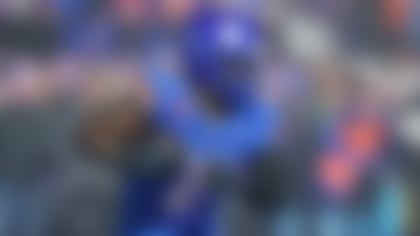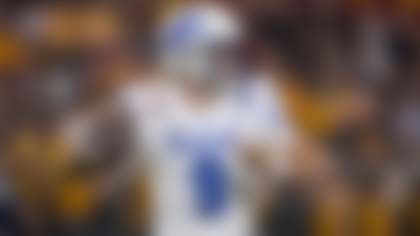Wins and losses don't count in the NFL preseason -- but individual performances sure do. After each week's slate of preseason action, Bucky Brooks will shine the spotlight on one notable player from each team in the league, grading that player's performance and providing a snapshot of how he's doing in this critical dress-rehearsal phase of the 2015 campaign. The performance grading scale is as follows:
A: Masterful
B: Strong
C: Acceptable
D: Marginal
F: Unacceptable
EAST
Dallas Cowboys: La'el Collins, OG
GRADE: A
Strengths: Collins is a people-mover at the point of attack. The rookie overwhelms blockers with his combination of first-step quickness and explosive strength, yet he also displays the balance, body control and agility to work on the second level. When Collins puts his hands on defenders in space, it can get ugly, as evidenced by this pancake block of Chargers linebacker Chi Chi Ariguzo in Thursday night's matchup, or his spectacular effort paving the way for Gus Johnson on the Cowboys' lone touchdown of the night.
Weaknesses: Collins has the look of a dominant mauler/brawler-type blocker, but his persistent clutching could result in penalties down the road. He needs to monitor his hand placement to ensure he doesn't snatch cloth on the shoulder of the defender, leading to a holding call from a nitpicky official.
What he needs to work on: Collins certainly played up to his pre-draft hype in his preseason debut. He dominated opponents at the line of scrimmage and didn't look out of place when playing with the 1's. If Collins can continue to move people in the running game and display body control in pass protection in Week 2, it is going to be hard to keep the rookie out of the starting lineup when the regular season opens.
New York Giants: Devon Kennard, LB
GRADE: C+
Strengths: Kennard is poised to become a star as a hybrid playmaker for the Giants. The second-year pro is an active Sam linebacker with the strength and power to beat up tight ends at the line of scrimmage, but he also displays the quickness and burst to harass quarterbacks off the edge. He flies around the ball with reckless abandon and was one of the few bright spots in the Giants' loss to the Bengals on Friday.
Weaknesses: For all of Kennard's effort and hustle, he still needs to display better awareness in pass coverage. He locks onto the first receiver who ventures into his area and doesn't keep vision on the quarterback to track when the ball is thrown. Consequently, he is a step or two late when the ball goes to a receiver in a nearby zone, which is what happened on Tyler Eifert's 18-yard reception on the Bengals' second drive.
What he needs to work on: Kennard must continue to make strides as a pass defender. He doesn't have a good feel for playing receivers in space; he needs more work adjusting to dropping into space and sorting through route recognition. If he can learn to quickly diagnose the key areas of coverage, Kennard could dazzle as the Giants' utility man on the front seven.
Philadelphia Eagles: Nelson Agholor, WR
GRADE: B-
Strengths: Agholor is an outstanding catch-and-run specialist on the perimeter. The rookie excels at making defenders miss in space, but he also possesses the strength and power to run through arm tackles.
Weaknesses: The first-round pick is a natural pass catcher with strong hands, but he occasionally struggles with concentration drops. Agholor allowed an easy pass to slip through his fingers along the sidelines against the Colts on Sunday and failed to come down with a 50-50 ball in traffic.
What he needs to work on: Agholor certainly made a strong impression on Philly fans with his 34-yard touchdown on a spectacular catch-and-run maneuver Sunday, but coaches will want to see him consistently come down with balls thrown in his direction. If he eliminates the concentration drops, Chip Kelly will make him a feature player in the Eagles' high-octane offense.
Washington Redskins: Matt Jones, RB
GRADE: B
Strengths: Jones is a hard-nosed, physical runner with surprising balance and body control. The third-round pick runs through arm tackles in the hole, yet flashes enough agility and lateral quickness to bounce outside when he spots a crease.
Weaknesses: Questions persist about Jones' ability to catch the ball out of the backfield, due to the rookie's limited production as a receiver at Florida. Although he notched an 11-yard reception against the Browns on Thursday, he needs to show coaches he is capable of catching screens and swings out of the backfield.
What he needs to work on: Jones, who popped off runs of 23 and 12 yards on consecutive carries in the preseason opener, must continue to produce positive gains with his rugged running style. Redskins coaches will want to see him earn the hard yards in traffic to feel better about his chances as a fill-in. Jones could further cement his status as a top backup by catching the ball consistently as a receiver out of the backfield.
NORTH
Chicago Bears: Eddie Goldman, DT
GRADE: B-
Strengths: The Bears desperately need a nose tackle with "knock-back" power and anchor ability to key their transition to a 3-4, and Goldman definitely shows those traits as a young player. The second-round pick controls the middle with his size and strength while exhibiting impressive instincts and awareness chasing the ball.
Weaknesses: Goldman has limitations as a pass rusher. He's more of a pocket pusher on the interior and doesn't fully showcase a wide array of rush moves at the point of attack.
What he needs to work on: Goldman is a rock-solid run stopper at the point of attack, but he needs to remain active and aggressive on pass downs. He was in on 26 defensive snaps in the preseason opener on Thursday, but he can earn more playing time by demonstrating a versatile game that encourages the Bears' staff to keep him as a three-down player. If Goldman can flash an effective arm-over or bull-rush move to generate penetration up the gut in Week 2, John Fox certainly would consider enhancing the rookie's role in the rotation.
Detroit Lions: Ameer Abdullah, RB
GRADE: A
Strengths: Whenever an opposing coach likens a runner's game to that of Barry Sanders -- as Jets coach Todd Bowles did following Abdullah's performance in his team's matchup with the Lions on Thursday -- evaluators take notice. Abdullah's play merited rave reviews. The ex-Nebraska standout showed off extraordinary balance, body control and vision with the ball in his hands en route to posting 67 yards on just seven carries. He demonstrated remarkable wiggle and elusiveness in the hole, flashing an impressive lateral jump-cut that only special runners are able to execute in tight quarters. Considering Abdullah also displayed soft hands and strong receiving skills as a pass catcher out of the backfield, it is hard to contain the excitement about the rookie's potential as a feature back in the Lions' offense.
Weaknesses: Abdullah's size (5-foot-9, 205 pounds) and strength are concerns when considering his chances of survival as a full-time running back. The second-round pick lacks the girth to take the pounding as an inside runner; this relative dearth of bulk also prevents Abdullah from employing a physical running style to break tackles on power plays.
What he needs to work on: To win the RB1 job, Abdullah must convince Detroit's coaches that he can effectively run between the tackles against a loaded box. With defenders more aware of his dangerous "shake-and-bake" running style, Abdullah needs to show a diversified game to enhance his chance of earning the workhorse role.
Green Bay Packers: Ty Montgomery, WR
GRADE: B+
Strengths: Montgomery is a physical pass catcher with outstanding speed and quickness. The third-round pick shows rare burst and acceleration with the ball in his hands; his dynamic running skills as a returner also make him a dangerous threat as a two-phase contributor. Although Montgomery's hands and ball skills have been cited as concerns, the rookie caught the ball well in Thursday's preseason opener against the Patriots. He flashed exceptional concentration making an acrobatic catch along the boundary that was eventually ruled incomplete due to his inability to keep his feet in bounds. Despite the outcome, that play showcased his ball skills and overall athleticism.
Weaknesses: Montgomery is a better athlete than pure receiver. He needs to continue to refine his technique as a route runner in the Packers' intricate offense. While he is certainly capable of shining on various catch-and-run throws like slants and crossers, Montgomery can earn a bigger role by mastering the double moves and exotic routes that are also a staple in the Packers' offense.
What he needs to work on: Montgomery needs to make steady progress as a route runner. He has the raw athleticism and skill to be a monster in the Packers' system, but he has to earn the trust of quarterback Aaron Rodgers by consistently getting to his designated spot on time.
Minnesota Vikings: Trae Waynes, CB
GRADE: C
Strengths: Waynes is a natural bump-and-run corner with outstanding speed and athleticism. The 11th overall pick is comfortable playing nose to nose with receivers, exhibiting solid footwork and patience early in routes. Waynes is still adjusting to the NFL rules regarding contact, but the rookie's positioning and effectiveness as a press corner stand out on tape.
Weaknesses: Waynes' limited experience with "off" technique at Michigan State has been exposed in the NFL. He does not seem nearly as comfortable playing from a pedal, and he lacks the understanding of splits and proper leverage when working in space. As a result, he gives up big plays on vertical throws by aligning improperly and failing to play towards his help. Vincent Jackson's 40-yard catch in the Vikings' matchup with the Buccaneers on Saturday was the byproduct of Waynes playing from an outside shade position on the veteran receiver despite the potential lack of help from the safety in the coverage (quarter-quarter-half).
What he needs to work on: Waynes must continue to refine his technique from "off." He needs to focus on aligning properly prior to each snap and understanding where his help is located on the field. If he can start to put together those pieces of the puzzle, he should improve quickly as a cover corner.
SOUTH
Atlanta Falcons: Vic Beasley, OLB
GRADE: B-
Strengths: Beasley displays impressive speed and first-step quickness off the ball. The eighth overall pick is a natural pass rusher with the burst and explosiveness to wreak havoc on opponents off the edge. Beasley's penetration off the corner led to the interception of Titans quarterback Marcus Mariota in Friday's preseason matchup -- Beasley's outstretched hands forced Mariota to lob a screen pass into Falcons linebacker Justin Durant's hands -- and quickened the clock in the rookie signal caller's head.
Weaknesses: Beasley struggles setting the edge against the run. The 6-3, 246-pound rookie lacks the size and strength to hold his ground against big, physical blockers at the point of attack. Although he bounced off and made an impressive tackle on a Bishop Sankey run on Friday, Beasley needs to continue to work on his leverage and anchor against runs in his direction.
What he needs to work on: Beasley has the potential to blossom into a disruptive force as the Falcons' "Leo," but he must show the coaching staff that he can hold up against the run. If Beasley plays with better leverage and fully uses his length to keep blockers at bay in Week 2, he could take another step toward becoming a solid edge player in coach Dan Quinn's aggressive scheme.
Carolina Panthers: Devin Funchess, WR
GRADE: B
Strengths: It is easy to fall in love with big-bodied pass catchers who have the size and length to expand the strike zone on the perimeter. Funchess (6-4, 225 pounds) excels on "post-up" plays and jump balls down the boundary, as evidenced by a nifty 34-yard catch in Friday's matchup with the Bills that showcased his ballerina-like footwork and superb body positioning. The rookie also narrowly missed out on a spectacular grab on a 50-50 ball in the back of the end zone. The Panthers should be encouraged by his potential as a big-play weapon on the outside.
Weaknesses: The second-round pick's lack of speed and quickness will lead to more 50-50 plays on the outside. He doesn't have the burst to run away from elite defenders, which will force quarterback Cam Newton to fit the ball into tight windows in key situations.
What he needs to work on: Funchess must become a more aggressive and physical receiver on the outside. He lacks the speed and explosiveness to consistently win with finesse. Thus, he must discover different ways to use his size and physicality to his advantage. If he can continue to master the "push-off" and "post-up" on the perimeter, he can become a very effective possession receiver for the Panthers.
New Orleans Saints: Brandin Cooks, WR
GRADE: B+
Strengths: Cooks is a polished receiver capable of aligning anywhere on the field. The second-year pro is a spectacular route runner, but he is most dangerous as a catch-and-run specialist in the Saints' quick-rhythm offense. He can turn short passes into big gains quickly, as evidenced by his sole catch in Thursday's matchup with the Ravens: a 28-yard touchdown on a tunnel screen in the second quarter. Cooks definitely possesses all of the tools needed to shine as a WR1 in the Saints' offense.
Weaknesses: Cooks (5-10, 189 pounds) is smaller than a prototypical WR1. He lacks the length to win 50-50 balls on the outside and his slender frame makes it tough for him to overwhelm physical corners at the line. Cooks didn't have a problem getting open against the Ravens' aggressive tactics, but fighting for space on every down could wear on the diminutive playmaker over the course of a game.
What he needs to work on: Cooks must show Saints coach Sean Payton that he can win against various coverage tactics during the preseason. He will be viewed as the Saints' top option, and thus must be prepared to win against "cloud" corners and bump-and-run specialists if he is to post significant production as the WR1. How well he fares in Week 2 with extended playing time could give Payton an indication of his long-term potential as the focal point of the passing game.
Tampa Bay Buccaneers: Jameis Winston, QB
GRADE: C+
Strengths: There is no disputing Winston's arm strength, anticipation and timing as a pocket passer. He aggressively pushes the ball downfield on vertical throws and also shows the ability to make touch passes on short and intermediate routes. Winston's rhythm was impressive for a young passer facing an aggressive Vikings pass rush in Saturday's preseason showdown. The rookie also deserves kudos for his ability to buy time and maneuver around the pocket.
Weaknesses: I remain concerned about Winston's ball-security issues after watching him toss an interception and deal with a series of bobbled snaps in the backfield Saturday. For the Bucs to win, he must limit his turnovers -- and yet, he continues to have gaffes that put the ball in harm's way. In addition, Winston must find a way to eliminate the sacks (two against Minnesota) and negative plays in the passing game. He has to mask the deficiencies of his inexperienced line by getting the ball out of his hands on time. Sure, this is a lot to ask of a first-year pro, but the No. 1 overall pick in the 2015 NFL Draft is held to a higher standard based on his talent and potential.
What he needs to work on: Winston must continue to progress as a decision maker. He has to understand the importance of ball security while playing in an aggressive manner from the pocket. There is a fine line between game manager and gunslinger; Winston has to understand the difference to become an effective starter.
WEST
Arizona Cardinals: Ifeanyi Momah, TE
GRADE: B
Strengths: It's hard to find 6-7, 255-pound athletes with soft hands and impressive movement skills. That's why the Cardinals are intrigued by Momah's potential as a developmental tight end prospect after signing him as a free agent following the NFL's Veteran Combine. The third-year pro catches the ball well for a big man, exhibiting strong hands and flexibility on a shoestring catch in Saturday's matchup with the Chiefs. Momah's length and athleticism should make him an intriguing chess piece for Cardinals coach Bruce Arians to play with on the perimeter.
Weaknesses: Momah is still a work in progress as a blocker. Despite possessing the strength and power to move defenders off the ball, he struggles with his technique, and the lack of balance prevents him from consistently finishing his blocks on the edge. If he can clean up his footwork and balance, he could be a nightmare to deal with at the point of attack.
What he needs to work on: Momah's blocking prowess must improve for him to clinch a roster spot. If he can be a sticky presence on the edge, Momah could fill the role of the TE2 and enhance the Cardinals' passing game as a big target over the middle of the field.
St. Louis Rams: Tavon Austin, WR
GRADE: B+
Strengths: No one has ever questioned Austin's home-run potential as a dynamic offensive weapon. The third-year pro is electric with the ball in his hands, exhibiting exceptional speed, quickness and wiggle in the open field. The Rams took advantage of his skills by getting him a touch on a "now" screen early in Friday's matchup with the Raiders, which turned into a 35-yard gain after Austin dipped and dodged multiple tacklers on the perimeter.
Weaknesses: Austin needs to continue to work on his route-running skills as a potential WR1. He has made strides over the past two seasons, but he needs to refine his stems and explosiveness out of breaks. It's hard for some speedsters to master the stop-start phase of route running, but Austin has body control and agility to execute the maneuver with diligent work.
What he needs to work on: Austin has teased scouts with his potential in the past, but he appears to be a more polished player in Year 3. He needs to show off his improved route-running skills in extended action in Week 2 to build on the momentum created by his spectacular highlight run in the preseason opener.
San Francisco 49ers: Jarryd Hayne, RB
GRADE: B-
Strengths: It is uncommon for a rugby player to transition to the NFL at a skill position, but Hayne is quickly acclimating to the pro game as a runner. He exhibits solid instincts and awareness with the ball in his hands, showcasing a nice feel for finding creases in the middle of the defense. As a kick returner, he is patient attacking the seam but shows the burst and physicality needed to churn out 30-yard gains.
Weaknesses: Hayne is a bit of a straight-line runner with limited wiggle in the open field. He stays on his tracks and rarely deviates from his assigned route. While some coaches appreciate a one-cut runner with patience, Hayne needs to show more creativity to be a successful runner as a pro.
What he needs to work on: Hayne certainly caught the attention of coaches and scouts with his 53-yard runagainst the Texans on Saturday, but he will need to show evaluators that he can elude and evade defenders in traffic. The 49ers feature a power-based running game that primarily operates between the tackles. Thus, Hayne will need to exhibit the toughness, physicality and wiggle to consistently produce positive gains when he is the feature back on the field.
Seattle Seahawks: Tyler Lockett, WR
GRADE: A+
Strengths: Lockett is an electric playmaker in the open field. The third-round pick has a knack for making defenders miss in space, yet he is a disciplined runner adept at gaining positive yards while taking risks. His outstanding exhibition on kickoff returns against the Broncos on Friday -- including a 103-yard score and a 46-yard return -- showcased his vision, balance, body control and burst. The Seahawks were wise to invest heavily in the two-time Big 12 Special Teams Player of the Year.
Weaknesses: Lockett, who played just 10 offensive snaps and wasn't targeted once Friday, didn't get an opportunity to showcase his skills a receiver, but the slender pass catcher needs to work on escaping press coverage against physical corners. Young receivers routinely struggle against physical corners at the line; the rookie's size (5-10, 182) will hinder his ability to stay on course until he develops a series of finesse escapes that force corners to alter their approach.
What he needs to work on: It is hard to find a flaw in Lockett's return technique. He is a disciplined runner with outstanding vision, quickness and burst. He hits the hole at 100 mph, yet understands when to change tempos to attack a crease on the back side. Lockett can continue to work on ball security and situational awareness, but some guys have rare kick-returning abilities -- and he is one of them.
Follow Bucky Brooks on Twitter @BuckyBrooks.












